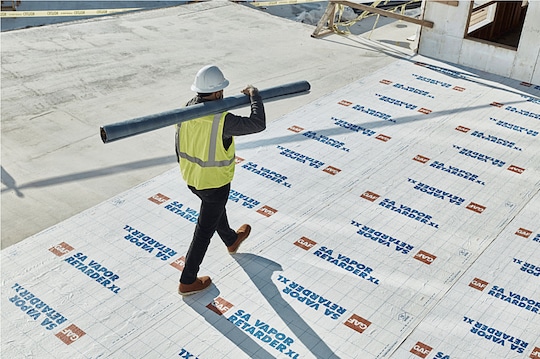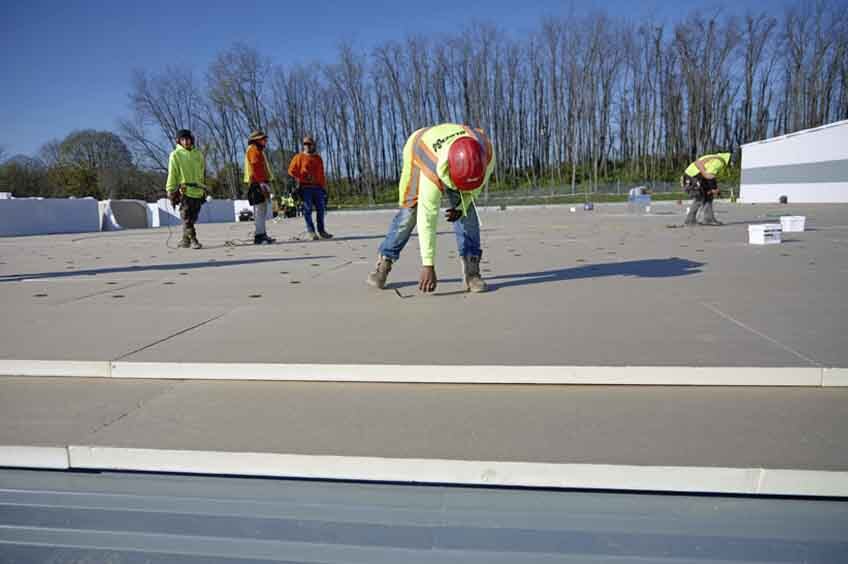
The polyiso insulation you choose for your commercial roofing project can make a big difference in terms of durability and performance of your roofing system. But with so many options on the market, it can be easy to get lost in the details and risk choosing the wrong material for your project.
Knowing how to pick the right polyiso roof insulation starts with knowing what the needs of your project are. Here's a primer to get you started toward picking the best option for your project.
Why Use ISO Roof Insulation?
Polyisocyanurate, often referred to in the roofing industry as polyiso or ISO for short, is a rigid foam insulation sandwiched between two facers. The Polyiso Manufacturers Association (PIMA) says that polyiso roof insulation is used in 70 percent of all commercial roofing systems.
Polyiso roof insulation is a popular choice because of the many benefits that it delivers to the building owner as well as the contractor. One reason for its popularity is that it offers the highest R-value per inch compared to any other type of non-polyiso insulation of equivalent thickness. It is compatible with virtually all types of roofing systems, including single-ply, built up, modified bitumen, and metal roofs. Additionally, due to the chemical makeup of the foam, some ISO products can also help your roofing system achieve a fire resistance rating.
Contractors find that the standard 4' x 4' and 4' x 8' boards are lightweight, easy to maneuver, and easy to cut to size or shape quickly with a regular hand saw. The light weight of polyiso boards also makes them easier to lift and load onto the job site. Polyiso boards are also available in 4' x 4' tapered panels that are available in various slopes.
Polyiso roof insulation is manufactured with EPA-compliant blowing agents containing no CFC's or HCFs. Additionally, polyiso has zero ozone depletion potential (ODP) and negligible global warming potential (GWP). The high R-value can also improve a building's energy efficiency and help reduce cooling and heating loads.
Types of ISO
Polyiso is a very versatile insulation solution because it's available with a variety of facer types for every project's needs. These include a glass fiber-reinforced cellulosic felt facer, reinforced mat facer, and coated glass facer.
Mark Graham, VP of Technical Services for the National Roofing Contractors Association (NRCA), laid out these guidelines to help you decide which type of ISO facer works best with which roofing system:
- Reinforced mat facers are appropriate for virtually all types of roofing systems
- Coated glass facers work best with single-ply roofing membranes, but should be adhered with water-based adhesive
- Uncoated glass facers are best used with hot-applied, built-up, and modified bitumen roofing systems
Choosing the Right ISO Roof Insulation
Understanding which facer is recommended for a particular type of roofing system is important, but you should also consider the desired characteristics you want from your particular roofing project. Are you looking for energy savings? Moisture resistance? Surface strength? Once you understand the needs of the building and the project, you can confidently choose the right polyiso solution.
Here are some of the performance characteristics specifiers often look for and the corresponding facer suggestions:
- Moisture protection: If you are looking for optimal protection against moisture, you'll want to choose ISO with a coated glass fiber facer.
- Fire resistance: If you are looking for optimal fire resistence, choose polyiso that features coated glass fiber facers on both sides of the board. Another option is polyiso that uses a coated glass-fiber facer on the bottom and a premium coated glass-fiber facer on the top.
- Surface strength and durability: If surface strength is important, consider a polyiso solution that features a premium glass-coated fiber facer with a tighter weave than standard coated glass-fiber or paper-faced polyiso.
Whatever your project's needs, you'll find a solution in the GAF EnergyGuard™ line of polyiso products. Each ISO roof insulation option from GAF also comes in a non-halogenated (NH) form that can help buildings meet sustainability requirements and even help contribute toward LEED* points.
If you still have questions or want additional guidance on choosing the right polyiso for your roofing project, the experts at GAF are here to help.
*LEED® — an acronym for Leadership in Energy and Environmental Design™ — is a registered trademark of the U.S. Green Building Council.






